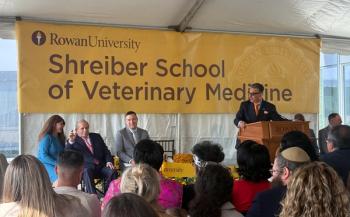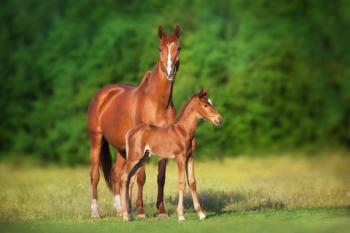
Common geriatric equine diseases (Proceedings)
This lecture will focus on common diseases of older horses including dental disease/weight loss (and other complications of poor dentition), recurrent airway obstruction, lameness and common neoplasms of older horses.
Older horses are at risk for developing a number of diseases. This lecture will focus on common diseases of older horses including dental disease/weight loss (and other complications of poor dentition), recurrent airway obstruction, lameness and common neoplasms of older horses.
Weight Loss/Dental Disease
Dental Disease:
Most geriatric horses have some degree have some dental disease, and some can have severe dental abnormalities.
Periodontal disease=presence of disease and loss of tissue that surround the tooth, which includes the alveolus (bony socket), cement, and gingival. Oral examination reveals gingival hyperemia, edema, and ulceration, deepening of periodontal pockets, and packing feed material. The tooth may be loose.
Diastema=abnormal detectable space between the teeth, that accumulates feed. This results in pain and quidding. Treatment includes daily lavage, removal of sharp enamel points, tooth reduction, and feeding soft feeds or grass.
Malocclusions: can be severe in geriatric horses. Treatment includes reduction of hooks, ramps and steps. Use of power equipment is helpful. Care should be given to prevent thermal injuries. Care must be taken if using molar cutters in older horses.
Smooth mouth: absence of enamel on the occlusal surface of the cheek teeth. As the enamel wears out the dentin and cement are exposed resulting in rapid wear of the teeth.
Dental caries/tooth root abscess
Consequences of Dental Disease: Weight Loss, Choke, Large Colon Impactions
Weight Loss: Most common cause is likely related to poor dentition; chronic intestinal parasitism can be more of a problem in older horses, in addition to other more serious systemic diseases resulting in weight loss.
Recommended Feeding for Older Horses:
There are rations made specifically for geriatric horses that are easier to digest and masticate. Most designed to be "complete feeds", and may be used as a sole ration. They include a combination of roughage, energy concentrates, protein supplementation, and mineral and vitamin supplements. The roughage is usually consists of dehydrated alfalfa meal and/or beat pulp. The energy concentrates include cereal grains (corn, oats, and barley) and fat. The cereal grains in complete feed often undergo heat treatments (extrusion, pelleting) which results in gelatinization and starch molecules (which will increase their availability for digestion and absorption. Hay (if can be tolerated) can be feed to prevent boredom. To note, complete feeds have a significant amount of cereal grains in horses with insulin resistance.
Other options: chopped hay (alfalfa or mixture of high quality grass hay/alfalfa mixture). Chopping hay minimizes the amount of mastication needed. It may increase dust/fine particles (may need to wet the hay). Generally, consumption of 1.5-2% (dry matter) of body weight of forage (grass, hay) is adequate to meet a horse's digestible energy requirements. Ensiled or chopped hay will have a higher moisture content, and it is important to take this into account. It probably necessary to add a vitamin-mineral supplement. Vegetable oil can be added to the diet (1-2 cups/day) if necessary to maintain weight.
Esophageal obstruction: Dental disease resulting in poor mastication can result in esophageal obstruction.
Clinical signs include coughing, retching, bilateral green (food) nasal discharge.
Diagnosis: not difficult; failure to pass NG tube; additional- endoscopy, radiographs (if complicated), blood work (chronic cases), assessment of lungs (aspiration pneumonia)
Treatment: early cases: withhold feed and water, sedation, anti-inflammatory drugs, oxytocin (0.11-0.22 iu/kg iv- caution in mares), broad spectrum antibiotics; more aggressive treatment necessary if not resolved in 4-6 hours: heavy sedation, careful esophageal lavage; in some cases general anesthesia.
Sequella: Recurrence of choke: concerns- stricture #1; further work-up (endoscopy, contrast radiographs); options- could be addressed surgically; life-long gruel diet in some cases
Large Colon Impaction: poor dentition most likely risk factor
Clinical signs: variable- mild-moderate signs of colic, depression, decreased appetite decreased fecal production
Diagnosis: rectal palpation
Treatment: feed restriction, analgesics, administration of oral fluids and laxatives; intravenous fluids if necessary; laxatives include- mineral oil, diocytl sodium succinate 6-12 g/500kg; magnesium sulfate (0.1 mg/kg given in 2-4 L of water)
Recurrent Airway Obstruction
Recurrent airway obstruction (RAO, heaves) is the most common respiratory disorder in geriatric horses. RAO is characterized by bronchospasm, excessive mucous production, and pathologic changes of the bronchiolar walls that result in terminal airway obstruction. Geriatric horses often have more severe clinical signs due to RAO than younger horses. RAO is usually a drug-responsive disorder in middle-aged horses, but as the horse ages, horses are more likely to have permanent pulmonary remodeling and fibrosis.
Clinical signs: flared nostrils, chronic cough, and nasal discharge. Respiratory impairment may range from exercise intolerance to dyspnea at rest. An increase in expiratory effort can be noted. In severe cases tachypnea, weight loss, and a heave line may be present. Auscultation can range from normal to abnormal (expiratory wheezes and in some cases crackles. Horses should be afebrile.
Diagnosis: In most geriatric horses with advanced disease, the diagnosis is based on clinical signs and history. Performing other diagnostic tests (such as a CBC, thoracic ultrasound) can be important to rule out other diseases including bacterial pneumonia or less common diseases (such as neoplasia or interstitial pneumonia). In horses with subtle disease, bronchoalveolar lavage (BAL) can be helpful to examine cytological samples from the lower airways.
Treatment: The primary goal is prevention of exposure of allergens combined with intermittent medical treatment of the inflammation and bronchocontriction.
Environmental Management: Reduce dust, increase ventilation, change feed (no round bales, wet hay, or avoid hay)
Anti-inflammatory Drugs:
Systemic corticosteroids: indicated with severe/moderate RAO- "Rescue Drugs". Associated with laminitis, immunosuppression and adrenal suppression.
Dexamethasone: drug of choice. 0.02-0.05 mg/kg iv (up to 0.1 mg/kg)- improves clinical signs by day 3 maximal response at day 7. Adrenal suppression 3 days after discontinuation. Usually use for 10-14 days, decreasing dose, alternate day therapy, and orally
Oral prednisone: has been shown not be effective with horses with RAO, and is likely poorly absorbed; Oral prednisolone also has a very short duration.
Use of NSAID and anti-histamines- are not effective
Aerosolized corticosteroids: effective for mild-moderate disease. To note- that in horses there still is adrenal suppression associated with the use of aerosolized steroids (which is not true in humans). There are 3 aerosolized corticosteroid products in metered-dose inhalers, listed in order of potency: fluticasone propionate> beclomethasone dipropionate> fluisolide
Delivered to horses via: Equine AeroMask® (Trudell Medical International , London, Ontario) or Equine Haler® (Equine Healthcare APS, Hillerod Denmark)
Fluticasone: dose 2000 ug SID to BID/adult horse; Glaxo Wellcome Flovent® 220 ug/puff
Beclomethasone dipropionate: improvement in clinical signs within 24 hours; Doses range from 500-1500 ug SID to BID/adult horse; 3M Pharmaceuticals/QVAR® 40-80 ug/puff
Bronchodilators:
Most common are the B2 adrenergic agonist. Down regulation occurs resulting tolerance within 72 hours of use. Combining these drugs with corticosteroids will reduce the tolerance.
Oral Bronchodilators: Clenbuterol (Ventipulmin® ) oral B2; long acting, recommend intermittent dose scheduling to prevent side effects (tachycardia sweating). Terbutaline and albuterol have poor oral bioavailability
Aerosolized Bronchodilators:
Short acting: Albuterol Sulfate: 360-900 ug – "Rescue Drug" improves clinical signs in 5 minutes; can give a dose every 15 minutes for 2 hours; short lived (1 hour); Torpex® (no longer available); Schering Corporation/Proventil 90 ug/puff
Long acting: (not as a rescue drug)
Ipratropium bromide: antimuscarnic agent; little to no systemic absorption; 90-180 ug improves pulmonary function by 1 hour, duration 4-6 hours; 3M Pharmaceuticals/Atrovent® Combivent® : Ipratropium 21 ug/puff; Albuterol 120 ug/puff: can use 5-10 puffs BID/horse via Aeromask.
Atropine: "Rescue Drug" 5-7 mg IV/450 kg horse; will result in rapid bronchodilation. Several adverse side effects- colic, tachycardia, impaired mucociliary clearance). Should only be used as rescue therapy in life threatening situations.
Lameness
Lameness is a very common problem in geriatric horses. In many cases the severity of lameness can result in the need for euthanasia. Arthritis is the most common source of musculoskeletal pain in older horses. Progressive suspensory desmitis can also occur in geriatric horses, particularly older broodmares. Suspensory desmitis has been associated with a straight hock conformation. Other skeletal problems that can be seen in older horses include severe "sway-back". Arthritis of the cervical vertebral facets can result in neck pain. In some horses, this can result in spinal cord compression and ataxia.
Many geriatric horses with lameness problems can be managed successfully for a number of months to years. However, in some cases euthanasia may be necessary due to the progressive and severe nature of the lameness. Treatment of musculoskeletal problems in geriatric horses includes the use of non-steroidal anti-inflammatory drugs (phenylbutazone most commonly). Chronic use can result in NSAID toxicity. Other general recommendations for lameness due to arthritis include: 1) intra-articular steroid injections; 2) chrondroprotective agents (polysulfated glycosaminoglycan- Adequan- Luitpold Pharmaceuticals, glucosamine and chondroitin (Cosequin- Nutramax Labs); 3) Sodium hyaluronate (either intravenous or intra-articular); and 4) continued exercise (pasture turnout). Cervical vertebral facet injections with steroids will help provide analgesia in horses with neck pain.
Neoplasia
Melanocytic Tumors: The majority of gray horses will develop melanomas during their geriatric years.
Common location: perineum, underside of tail, prepuce, commissure of the lips and the parotid salivary gland. The tumors are slow growing, but can be locally invasive, and metastasize (especially in geriatric horses). Euthanasia can be necessary due complications of the melanoma in some cases.
Treatment: palliative at best. Surgical removal or cyrotherapy to remove a large mass that is causing a problem. Cimeiditine may reduce growth. An autologous vaccine made from the excised tumor can also be attempted.
Squamous Cell Carcinoma: Squamous cell carcinoma most commonly occurs on the genitalia, ocular structures, oral cavity and nasal sinuses. Appears as a raised or flattened fleshy mass that can be ulcerated.
Diagnosis: histology or cytology
Treatment: Early aggressive removal- wide surgical incisions if possible. Topical cisplatin or cisplatin in oil. There are reports of treatment with piroxicam (a selective COX-2 inhibitor) that resulted in successful remission of a squamous cell carcinoma.
Gastric Squamous Cell Carcinoma: tumor of the non-glandular portion of the stomach. Occurs in middle-aged to older horses. Quarter horses and draft breeds may be at an increased risk. Clinical signs include weight loss, colic, anorexia, recurrent choke.
Cholesterol Granuloma (cholesteatoma/cholesterinemic granuloma): is a non-neoplastic mass lesion that occurs within the choroids plexus of the lateral ventricle. Most incidental (up to 20% of aged horses). Cause? Repeated hemorrhage into the ventricle. If large enough can result in clinical signs.
Other Common Diseases of Geriatric Horses:
Ophthalmic diseases: Equine recurrent uveitis (ERU), and sequella (phthisis bulbi, glaucoma.
Cardiac disease: The most common cardiac diseases in older horses include degenerative valve disease, aortocardiac fistulas and congestive heart failure. Aortic regurgitation is most common in horses older than 10 years of age. Most horses tolerate aortic regurgitation well, and do not have any clinical signs.
Newsletter
From exam room tips to practice management insights, get trusted veterinary news delivered straight to your inbox—subscribe to dvm360.






